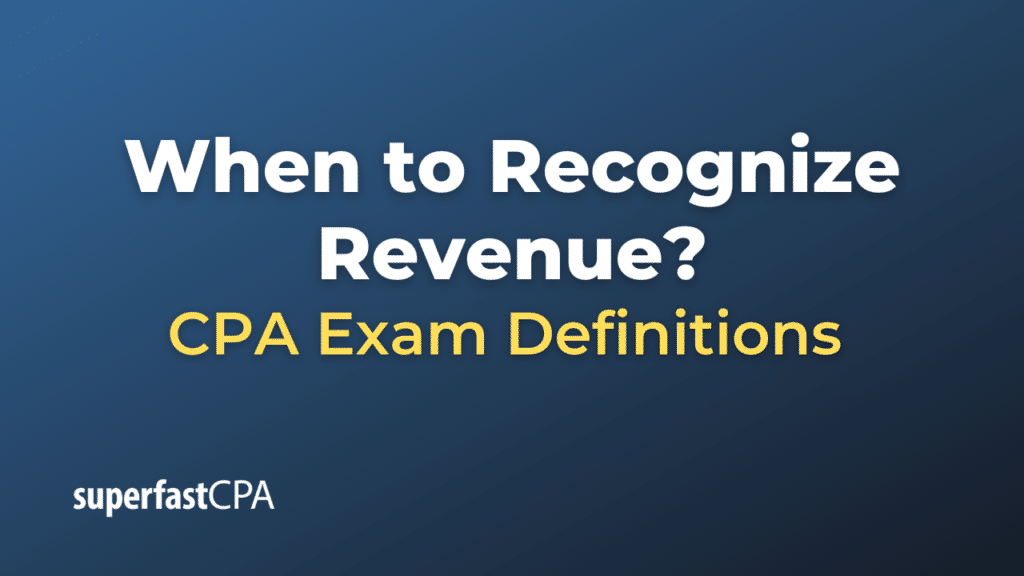When to Recognize Revenue
The recognition of revenue is an important aspect of accounting and financial reporting, and it’s governed by specific accounting standards. In the United States, the Financial Accounting Standards Board (FASB) has issued Accounting Standards Update (ASU) 2014-09, also known as Topic 606, “Revenue from Contracts with Customers,” which outlines the principles for recognizing revenue. Internationally, similar guidance is provided by IFRS 15.
According to these standards, revenue should generally be recognized when the following five-step process is completed:
Five-Step Process for Revenue Recognition:
- Identify the Contract with the Customer: A contract is an agreement between two parties that sets forth the terms, conditions, and other obligations.
- Identify the Performance Obligations: These are promises to deliver specific goods or services to the customer.
- Determine the Transaction Price: This is the amount the entity expects to receive in exchange for transferring goods or services.
- Allocate the Transaction Price to the Performance Obligations: If there are multiple performance obligations, the transaction price must be allocated to each one based on their relative standalone selling prices.
- Recognize Revenue When (or As) the Entity Satisfies a Performance Obligation: Revenue is recognized when control of the promised goods or services is transferred to the customer, either over time or at a point in time.
Example of When to Recognize Revenue
Let’s explore a more detailed example using the principles of revenue recognition. Consider a company named “AutoDeluxe,” which sells cars and also offers a 2-year free maintenance package with each car sold.
Scenario:
- AutoDeluxe sells a car for $30,000.
- The standalone price for the 2-year maintenance service is $2,000.
- The company receives $30,000 in cash upfront for the car and the maintenance package.
Here’s how AutoDeluxe would go about recognizing the revenue:
Step 1: Identify the Contract with the Customer
AutoDeluxe has a signed contract with the customer to deliver a car and provide 2-year free maintenance.
Step 2: Identify the Performance Obligations
AutoDeluxe has two performance obligations:
- Deliver the car
- Provide 2-year free maintenance
Step 3: Determine the Transaction Price
The total transaction price paid by the customer is $30,000.
Step 4: Allocate the Transaction Price to the Performance Obligations
To allocate the transaction price, AutoDeluxe needs to determine the standalone selling prices for the car and the maintenance package. Let’s assume the standalone selling price of the car is $28,500 and the maintenance package is $2,000. Thus, the total standalone selling prices sum up to $30,500.
- Allocation for the car: ( 28,500 / 30,500 x 30,000 = $28,033.61 )
- Allocation for maintenance: ( 2,000 / 30,500 x 30,000 = $1,966.39 )
Step 5: Recognize Revenue When (or As) Performance Obligations are Satisfied
- Car Delivery: The $28,033.61 would be recognized immediately upon delivery of the car to the customer, as that performance obligation is satisfied at a point in time.
Accounting Entry for Car Delivery:
Debit: Cash $28,033.61
Credit: Revenue from Car Sales $28,033.61 - Maintenance Package: The $1,966.39 would be recognized over the 2-year period (or 24 months), which works out to approximately $81.93 per month.
Accounting Entry for Monthly Maintenance Recognition:
Debit: Deferred Revenue $81.93
Credit: Revenue from Maintenance Service $81.93
Summary
In this example, AutoDeluxe identifies the contract and performance obligations, determines and allocates the transaction price, and then recognizes revenue as each performance obligation is fulfilled. The revenue recognition process ensures that the company reports revenue accurately and in line with accounting standards.













